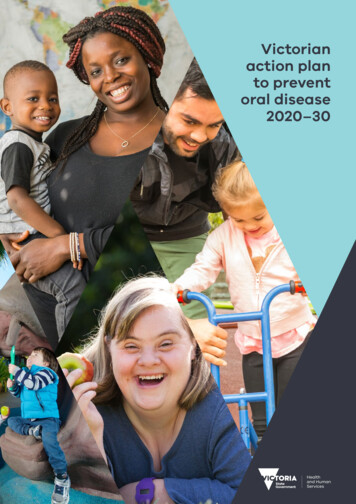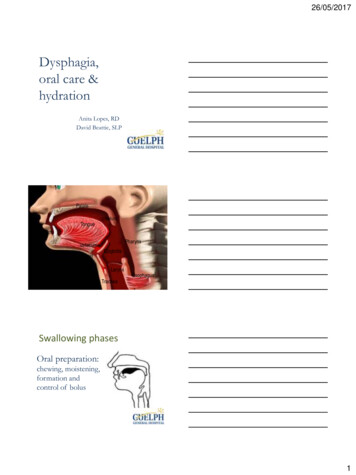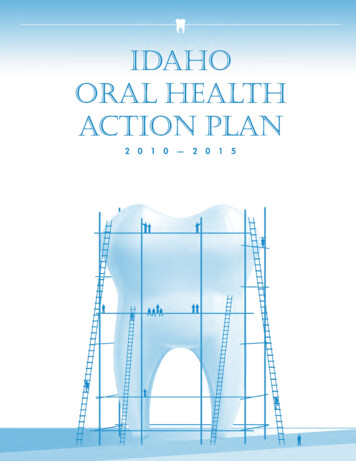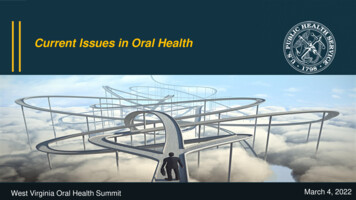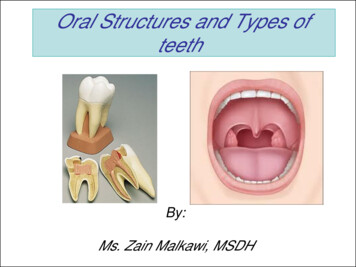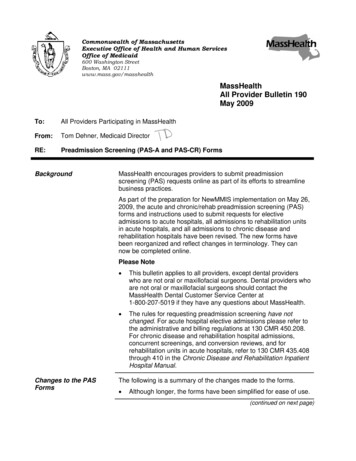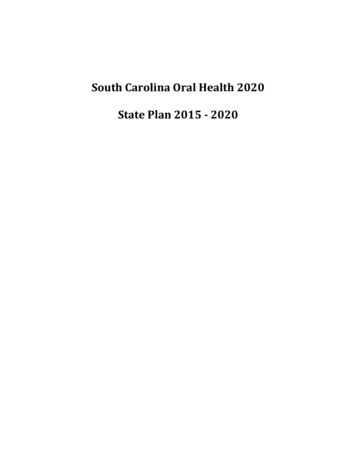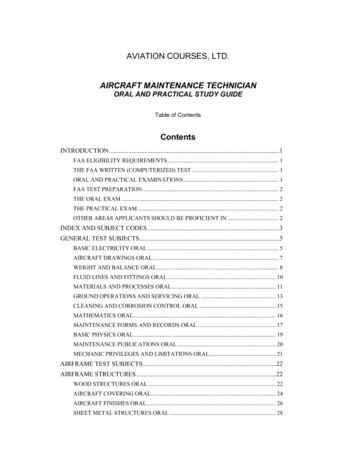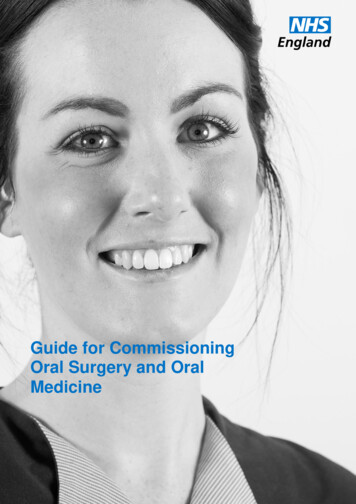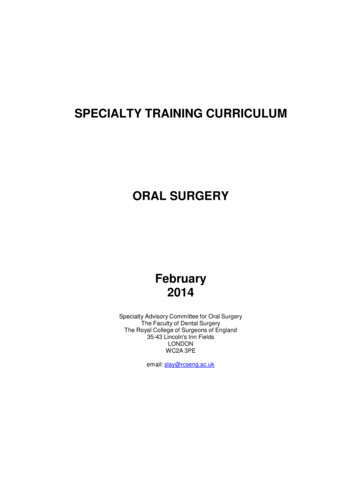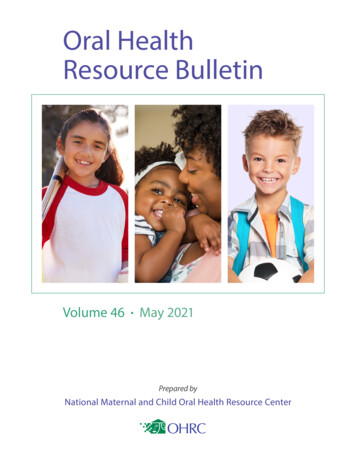
Transcription
Oral HealthResource BulletinVolume 46 May 2021Prepared byNational Maternal and Child Oral Health Resource Center
Cite asNational Maternal and Child Oral Health ResourceCenter. 2021. Oral Health Resource Bulletin: Volume 46.Washington, DC: National Maternal and Child OralHealth Resource Center.The following National Maternal and Child OralHealth Resource Center staff members assisted in thedevelopment of this publication: Katy Battani, SarahKolo, Susan Lorenzo, Beth Lowe, and Olivia Pickett.Oral Health Resource Bulletin: Volume 46 2021 byNational Maternal and Child Oral Health ResourceCenter, Georgetown UniversityPermission is given to photocopy this publicationor to forward it, in its entirety, to others. Requestsfor permission to use all or part of the informationcontained in this publication in other ways should besent to the e-mail address below.This publication was supported by the HealthResources and Services Administration (HRSA) ofthe U.S. Department of Health and Human Services(HHS) as part of an annual award totaling 1,000,000with no funding from nongovernmental sources. Thisinformation or content and conclusions are those ofthe author and should not be construed as the officialpolicy of HRSA, HHS, or the U.S. government, norshould any endorsements be inferred.National Maternal and Child Oral HealthResource CenterGeorgetown UniversityE-mail: OHRCinfo@georgetown.eduWebsite: www.mchoralhealth.org
ContentsAbout This Bulletin. . . . . . . . . . . . . . . . . . . . . . . . . 3Materials. . . . . . . . . . . . . . . . . . . . . . . . . . . . . . . . . . . . 4COVID-19. . . . . . . . . . . . . . . . . . . . . . . . . . . . . . . . 4Data and Surveillance. . . . . . . . . . . . . . . . . . . . 6Policy. . . . . . . . . . . . . . . . . . . . . . . . . . . . . . . . . . . . 7Professional Education and Practice . . . . . . 8Program Development. . . . . . . . . . . . . . . . . 14Public Awareness and Education. . . . . . . . 15Systems Integration. . . . . . . . . . . . . . . . . . . . . 16
About This BulletinThe Oral Health Resource Bulletin is a periodic publication designed to stimulate thinking and creativity within the maternal and child health communityby providing information about selected materialsof interest. Each successive volume is intended tosupplement rather than replace previous volumes. Thematerials listed in the bulletin have been incorporatedinto the National Maternal and Child Oral HealthResource Center (OHRC) library.Assessment (e.g., questionnaire,readiness assessment, survey)BookThe resource bulletin describes materials, such asbriefs, curricula, guidelines, manuals, reports, standards,and videos, published between 2019 and 2021. Eachresource includes an icon to help readers quicklyidentify materials. The key to the categories appearson the right.Brief, paper, or reportCurriculum (e.g., course, training)Our intent is to share materials that are useful andthat represent current science and practice. For furtherinformation, we encourage you to contact the organi zations listed. Your state and local departments ofhealth, state and local oral-health-related associationsand societies, state or local oral health coalitions, anduniversity-based libraries are additional sources ofinformation.Guide or guidelines (e.g., manual,pocket guide, practice guidance,resource guide, user guide)Infographic or posterOHRC is committed to continuing to provide effective mechanisms for sharing information about materials that enhance oral health programs and services. Ifyou have materials that you feel would be useful forprogram development, implementation, or evaluation,please become part of this process. If you have anymaterials that you think might be of interest, pleasee-mail a copy toTool (e.g., brochure, checklist,flipbook, flipchart, form,handout, tip sheet, toolkit)VideoNational Maternal and Child Oral HealthResource CenterGeorgetown UniversityWashington, DC 20057E-mail: OHRCinfo@georgetown.eduWebsite: www.mchoralhealth.orgO R A L H E A LT H R E S O U R C E B U L L E T I N : V O L U M E 4 6 . M AY 2 0 2 13
MaterialsCOVID-19Coronavirus Disease and Oral Health:Information for Parents AboutPromoting Good Oral Health at HomeCOVID-19: Oral Health Resource Kit—Faculty Resources for Integrating OralSystemic Health in CurriculaThis handout provides information for parents aboutpromoting good oral health at home during theCOVID-19 pandemic. It discusses the importance ofand provides tips for serving healthy foods and drinksand promoting good oral hygiene habits to keepchildren’s mouths healthy during the pandemic andalways. The handout is available in Chinese, English,Spanish, Tagalog, and Vietnamese.This toolkit includes COVID 19–related oral healthteaching resources for health professions faculty touse in classroom, simulation, and clinical settings.Resources include a case study of individuals acrossthe life span with oral health issues related to theCOVID-19 pandemic, a fact sheet about caringfor teeth during the pandemic, a fact sheet aboutaddressing problems with braces during the pandemic, a reference list of peer-reviewed articles andopen-source publications that highlight the linksbetween oral health and COVID-19, and a slide deckfor integrating a COVID-19 oral-systemic healthperspective into presentations.National Center on Early Childhood Health andWellness. 2020. Coronavirus Disease and Oral Health:Information for Parents About Promoting Good OralHealth at Home. Itasca, IL: National Center on EarlyChildhood Health and Wellness. 1 p.Oral Health Nursing Education and Practice. 2021.COVID-19: Oral Health Resource Kit—FacultyResources for Integrating Oral-Systemic Health in Curricula. New York, NY: Oral Health Nursing Education and Practice. 22 pp.Coronavirus Disease and Oral Health:Information for Parents About Visitingthe Dental OfficeThis handout provides information for parents abouttaking their child to the dentist during the COVID19 pandemic. It discusses the importance of gettingoral health care for children. It also lists changes thatdental offices may have made to lower the risk ofspreading COVID-19 to patients and parents. Thehandout is available in Chinese, English, Spanish,Tagalog, and Vietnamese.Dental Patient Care in the Era ofCOVID-19This fact sheet provides information about howCOVID-19 is changing the way oral health professionals are treating patients. Topics include safe oralhealth care, new ways to treat patients, what happensat the dental office, differing methods for providingtreatment, and what happens after the dental visit.National Center on Early Childhood Health andWellness. 2020. Coronavirus Disease and Oral Health:Information for Parents About Visiting the Dental Office.Itasca, IL: National Center on Early ChildhoodHealth and Wellness. 1 p.Organization for Safety, Asepsis and Prevention andDentaQuest Partnership for Oral Health Advancement. 2020. Dental Patient Care in the Era of COVID19. Boston, MA: DentaQuest Partnership for OralHealth Advancement. 2 pp.O R A L H E A LT H R E S O U R C E B U L L E T I N : V O L U M E 4 6 . M AY 2 0 2 14
How Should I Keep My Teeth HealthyDuring COVID-19Public Health Dental ProvidersEmbrace COVID-19 Related Changes:These Providers Are Faster toAnticipate and Adjust to ChangesAmid the PandemicThis flyer provides information for consumers abouthow to keep teeth healthy at home during theCOVID-19 pandemic. Tips include washing hands,brushing and flossing, eating a balanced diet, limitingsnacking and sugary drinks, drinking water, avoidingsmoking, replacing toothbrushes, and using toothpaste with fluoride. What to expect when going to adental office during the pandemic is also discussed.This report provides information from a survey aboutoral health professionals’ awareness of and concernsrelated to the COVID-19 pandemic. The report discusses differences in responses of oral health professionals who work in federally qualified health centersand other public health settings and those who donot. Topics include oral health professionals’ attitudesand priorities, likelihood of embracing telehealth, andstaffing challenges.DentaQuest, Virginia Health Catalyst. 2020. HowShould I Keep My Teeth Healthy During COVID-19.Boston, MA: DentaQuest; Glen Allen, VA: VirginiaHealth Catalyst. 1 p.DentaQuest. 2020. Public Health Dental ProvidersEmbrace COVID-19 Related Changes: These ProvidersAre Faster to Anticipate and Adjust to Changes Amid thePandemic. Boston, MA: DentaQuest. 7 pp.Interim Mask and Face ShieldGuidelinesThese guidelines for oral health professionals provide information about wearing masks and faceshields while treating patients during the COVID19 pandemic. Information about risk of infection isprovided, and a discussion of three mask types—N95,N95 equivalent, and surgical—is included. An illustration of each type of mask is also included.Summary, FAQ, and AdditionalGuidance for Health Directive 202009c: Required Best Practices for DentalHealth Care (upd. ed.)American Dental Association. 2020. Interim Maskand Face Shield Guidelines. Chicago, IL: AmericanDental Association. 1 p.This directive provides guidance for oral health carein San Francisco, California, during the COVID-19pandemic. Requirements, physical distancing protocol checklists, and strategies to reduce COVID-19transmission in oral health settings are included. Thedirective includes a summary and answers to frequently asked questions.Mott Poll Report: Pandemic-PosedChallenges to Children’s Oral HealthSan Francisco Department of Public Health. 2020.Summary, FAQ, and Additional Guidance for HealthDirective 2020-09c: Required Best Practices for DentalHealth care (upd. ed.). San Francisco, CA: San Francisco Department of Public Health. 12 pp.This report provides information from the results of aquestionnaire that asked a national sample of parentsabout oral health for their children ages 3–18 duringthe COVID-19 pandemic. Topics include whetherparents have tried to get oral health care for theirchild, parents’ perceptions of the safety of oral healthcare, changes to children’s oral health habits, andimplications for children’s oral health.CS Mott Children’s Hospital. 2021. Mott Poll Report:Pandemic-Posed Challenges to Children’s Oral Health.Ann Arbor, MI: CS Mott Children’s Hospital. 2 pp.O R A L H E A LT H R E S O U R C E B U L L E T I N : V O L U M E 4 6 . M AY 2 0 2 15
Talking to Parents About the Covid-19PandemicAmerican Academy of Pediatric Dentistry. 2020.Talking to Parents About the COVID-19 Pandemic.Chicago, IL: American Academy of Pediatric Dentistry. 2 pp.This handout provides information for parents aboutchildren’s oral health care during COVID-19. Topicsinclude how COVID-19 has impacted dental offices,what constitutes a dental emergency, whether goingto dental visits will be safe, what will be differentabout visiting the dentist, how to keep a child’s teethhealthy at home, how to prepare children for visiting the dentist, and whether it is necessary to bring achild to the dentist for regular preventive visits.Data and SurveillanceMaternal and Child Health Update:2020The Oral Health of 13–15 Year OldAmerican Indian and Alaska Native(AI/AN) Dental Clinic Patients:A Follow-Up Report to the 2013SurveyThis report presents the results from a 2020 survey ofsenior state and territory health officials on maternaland child health (MCH) policy topics, including oralhealth. Topics include governors’ MCH priorities,state and territory MCH priorities, and state and territory executive and legislative actions; coverage andpayment; and the MCH workforce. [Funded by theMaternal and Child Health Bureau]This report provides information about the oralhealth of 13–15-year-old American Indian andAlaska Native (AI/AN) dental clinic patients,comparing results from the 2019–2020 survey withresults from the 2013 survey. It presents a summaryof what’s new in the report since the 2013 survey andkey findings in three areas: (1) oral health of AI/ANadolescents over the past two decades, (2) oral healthdisparities in AI/AN adolescents compared with U.S.adolescents overall, and (3) percentage of AI/ANadolescents who had a dental visit in the past yearcompared with U.S. adolescents overall.National Governor’s Association. 2020. Maternaland Child Health Update: 2020. Washington, DC:National Governor’s Association. 27 pp.Phipps KR, Ricks TL, Mork NP, Lozon TL. 2020.The Oral Health of 13–15 Year Old American Indianand Alaska Native (AI/AN) Dental Clinic Patients:A Follow-Up Report to the 2013 Survey. Rockville,MD: Indian Health Service. 7 pp.O R A L H E A LT H R E S O U R C E B U L L E T I N : V O L U M E 4 6 . M AY 2 0 2 16
PolicyOral Health Policy Equity ToolDental Therapy Toolkit: A ResourcePrepared for Advocates and PartnersThis tool was designed to help advocates, organizers,funders, and other key stakeholders analyze policiesand center oral health agenda setting in the principles of equity and community engagement. Thetool includes (1) questions, discussion prompts, andresources to inform policy-agenda setting; (2) questions focused on how populations and marginalizedgroups will be affected by a policy, how inequitiesmight be addressed, and how advocacy efforts canfollow the lead of impacted populations and groups;(3) links to additional policy analysis tools; and (4) afollow-up survey.This toolkit includes a fact sheet on dental therapy, atimeline showing how dental therapy has evolved inthe United States, and a map showing where dentaltherapists are working or authorized and where legislation is being considered. A graphic on expandingthe oral health care team and one-pagers about theimportance and cost-effectiveness of dental therapyare included. The toolkit also includes several spotlights on dental therapists. Many of the topics arepresented as stand-alone documents.WK Kellogg Foundation. 2020. Dental TherapyToolkit: A Resource Prepared for Advocates and Partners.Battle Creek, MI: WK Kellogg Foundation. 22 pp.Community Catalyst. 2021. Oral Health Policy EquityTool. Boston, MA: Community Catalyst. 42 pp.Final Report 2019/2020 School Year:Adolescent Oral Health CampaignThis report provides information about the UtahDepartment of Health Oral Health Program’s2016–2017 oral health campaign, which was designedto educate middle- and high-school students aboutoral health care to encourage positive oral healthbehaviors and increase use of oral health services.The report discusses campaign goals and objectives,methods, results, limitations, and conclusions. Alsoincluded are survey questions on oral health behaviorand knowledge, post-test student intent questions,and qualitative questions.Neufeld L, Silver M, Cottom M. N.d. Final Report2019/2020 School Year: Adolescent Oral Health Campaign. Salt Lake City, UT: Utah Department ofHealth. 40 pp.O R A L H E A LT H R E S O U R C E B U L L E T I N : V O L U M E 4 6 . M AY 2 0 2 17
Professional Education and PracticeAll About FluorideChildren’s Oral Health: Demonstrationof the Five Oral Health Clinical CoreCompetenciesThis infographic provides information about thebenefits of community water fluoridation (CWF) forimproved oral health and how to find out whethera community’s water is fluoridated. The infographicalso provides suggestions on how to take action toimprove CWF, such as contacting state dental associations, talking about tooth decay prevention, sharing information with decision-makers, and preparingfor a city council vote or ballot initiative.This video shows a health professional performingthe five oral health clinical competencies, as recommended by the Health Resources and ServicesAdministration, during a well-child visit. The competencies include risk assessment; oral health evaluation;preventive intervention, including fluoride varnishapplication; communication and education, includingpatient engagement and self-management goal-setting; and interprofessional collaboration and practice, including dental referral and care coordination.[Funded by the Maternal and Child Health Bureau]American Dental Association, Action for DentalHealth. 2021. All About Fluoride. Chicago, IL: American Dental Association, Action for Dental Health.2 pp.University of Colorado, Public Health and DentalMedicine. 2020. Children’s Oral Health: Demonstration of the Five Oral Health Clinical Core Competencies.Denver, CO: CU Productions. 1 video (6:14 min.).Alternative Payment Method Modelsin Dentistry: A Provider PerspectiveThis report provides survey findings to understandoral health professionals’ knowledge about and willingness to participate in alternative payment models(APMs), in which they receive incentives to demonstrate value by preventing oral disease and keepingpatients healthy. The report provides informationabout value-based care, APMs, health professionals’awareness of APMs, and their interest in participating in such models.Community of Practice Curriculum:Education Training for Dental CareProviders—Guide for TrainersThis guide for trainers provides continuing education (CE) to oral health professionals serving infants,children, and adolescents from birth through age21, including children with special health care needs(CSHCN) and pregnant women. Topics include(1) introduction to public dental health and carecoordination; (2) behavioral guidance; (3) motivational interviewing; (4) early childhood oral healthcare; (5) tooth decay progression, management,diagnosis, and treatment; (6) restorative techniques;(7) cost-effective practice; (8) pediatric anestheticand behavior management; (9) oral health care forCSHCN and pregnant women; and (10) tobacco,vaping, and oral health.Apostolon D, McLeod C, Tranby EP, Mathews R.2020. Alternative Payment Method Models in Dentistry:A Provider Perspective. Boston, MA: DentaQuestPartnership for Oral Health Advancement. 6 pp.Alameda Public Health Department, Office of OralHealth. 2020. Community of Practice Curriculum: Education Training for Dental Care Providers—Guide forTrainers. San Leandro CA: Alameda Public HealthDepartment, Office of Oral Health. 69 pp.O R A L H E A LT H R E S O U R C E B U L L E T I N : V O L U M E 4 6 . M AY 2 0 2 18
Community Water FluoridationEvaluation of SEAL!ND: School Year2019–2020This fact sheet provides information about oral healthin Wisconsin, with a focus on how community waterfluoridation (CWF) can improve oral health status.The fact sheet includes an overview of the effects oftooth decay and information on how it affects children enrolled in Head Start, children in third grade,and older adults in the state. The impact of CWF ontooth decay is discussed. Strategies to promote oralhealth and CWF in Wisconsin are included.This report provides information about an evaluation of The North Dakota Department of Health,Oral Health Program’s school-based dental sealantprogram, SEAL!ND, which has been providing oralhealth screening, dental sealant and fluoride varnishapplications, education, and referrals for studentsthroughout North Dakota since 2012. The reportcovers the following topics: evaluation; clinical reachand dental referrals; participating school personnelperceptions of SEAL!ND; and reach of the relatedprogram, Ronald McDonald Care Mobile in partnership with Bridging the Dental Gap, which offersaccess to oral health care at additional schools in thestate.Wisconsin Department of Health Services. 2019.Community Water Fluoridation. Madison, WI: Wisconsin Department of Health Services. 2 pp.Dental Care Coordination and Accessto Care: How Local Dental PilotProjects Connect Children to DentalCare in California’s State MedicaidProgramSchroeder S. 2020. Evaluation of SEAL!ND: SchoolYear 2019–2020. Grand Forks, ND: Center for RuralHealth. 49 pp.Future of Public Oral Health inVirginia—Taskforce RecommendationsThis brief examines elements of oral health care coordination embedded within 12 of California’s DentalTransformation Initiative Local Dental Pilot Projects(LDPPs), part of the state’s Section 1115(a) Medicaidwaiver. The brief discusses how LDPPs define carecoordination, how they determine the effectivenessof care coordination, challenges they face in providing care coordination, facilitator factors for providingcare coordination, and challenges and facilitators tosustainability and replicability of care-coordinationefforts.These recommendations promote access to healthcare, including oral health care, for all Virginians.Recommendations are divided into the followingcategories: strengthen the oral health workforce,value the importance of oral health to overall health,employ data to improve outcomes and patient experience, and adapt technologies. For each category,objectives and strategies are presented.Virginia Health Catalyst. 2021. Future of Public OralHealth in Virginia—Taskforce Recommendations. GlenAllen, VA: Virginia Health Catalyst. 6 pp.Andrew K, Gonzales R, Alongi R. 2020. Dental CareCoordination and Access to Care: How Local Dental Pilot Projects Connect Children to Dental Care inCalifornia’s State Medicaid Program. Oakland, CA:Children Now. 3 pp.O R A L H E A LT H R E S O U R C E B U L L E T I N : V O L U M E 4 6 . M AY 2 0 2 19
Handbook on Planning, Evaluating,and Improving Collaboration for OralHealth ProgramsInside I-Smile: 2020 Update onChildren’s Oral Health in IowaThis report provides information about I-Smile, apreventive school-based dental program that focuseson improving the oral health of Iowa’s students. Thereport presents an overview of the program, describesits partnerships with the Special Supplemental Nutrition Program for Women, Infants, and Children(WIC) staff, physicians, and teachers; and discussesgaps that I-Smile fills.This handbook provides a framework and strategiesfor planning, evaluating, and improving programcollaboration to effectively and efficiently address oralhealth issues. Although many examples are targetedto oral health programs in state health agencies andstatewide oral health coalitions, the materials andconcepts apply to any community-based oral healthprogram or local coalition. The handbook provides arationale for improving program collaboration anddetailed steps on how to do so.Iowa Department of Public Health, Bureau of Oraland Health Delivery System. 2021. Inside I-Smile:2020 Update on Children’s Oral Health in Iowa. IowaDepartment of Public Health, Bureau of Oral andHealth Delivery System. 2 pp.Association of State and Territorial Dental Directors.2019. Handbook on Planning, Evaluating, and Improving Collaboration for Oral Health Programs. Reno, NV:Association of State and Territorial Dental Directors.44 pp.I-Smile @ School: 2019–2020 Updateon the Iowa Department of PublicHealth’s School-Based SealantProgramHealthy People 2020: An End ofDecade SnapshotThis report provides information about I-Smile, apreventive school-based dental program that focuseson improving the oral health of Iowa’s students. Thereport describes the program; the services it provides,which include oral health screenings, risk assessments, dental sealant and fluoride varnish application,and classroom and individual oral health education;student and school participation in the program; andprogram impact.This report provides a snapshot of the progress thatthe Healthy People 2020 initiative has achieved in thepast decade and highlights areas that need improvement. It includes background information aboutthe initiative and covers the following topics: tracking progress of objectives; status of leading healthindicators; status of objectives, including oral healthobjectives, by population subgroup; and transition toHealthy People 2030.Iowa Department of Public Health, Bureau of Oraland Health Delivery System. 2021. I-Smile @ School:2019–2020 Update on the Iowa Department of PublicHealth’s School-Based Sealant Program. Iowa Department of Public Health, Bureau of Oral and HealthDelivery System. 2 pp.Department of Health and Human Services, Officeof the Assistant Secretary for Health. 2020. HealthyPeople 2020: An End of Decade Snapshot. Washington,DC: Department of Health and Human Services,Office of the Assistant Secretary for Health. 36 pp.O R A L H E A LT H R E S O U R C E B U L L E T I N : V O L U M E 4 6 . M AY 2 0 2 110
Minnesota’s 21st Century Dental TeamToolkitNorth Dakota Department of Health,Oral Health Program NOFO DP18–1810 Year Two Evaluation ReportThis toolkit provides information about collaborativedental hygiene practice, dental therapy, and medicaldental integration. Each topic includes links to tutorials, videos, templates, and other tools. A resourcelibrary is included, with links to educational resources.A video with information about the toolkit is alsoincluded.This report provides information about an evaluationof the North Dakota Department of Health OralHealth Program, the purpose of which is to improvethe oral health of all North Dakotans throughprevention and education. The report addresses thefollowing topics: evaluation and stakeholder engagement; community water fluoridation; statewide oralhealth surveillance; and evaluation use, dissemination,and a sharing plan.Normandale Community College. 2020. Minnesota’s21st Century Dental Team Toolkit. Bloomington, MN:Normandale Community College. Multiple items.Schroeder S, Knutson S. 2020. North Dakota Department of Health, Oral Health Program NOFO DP18–1810 Year Two Evaluation Report. Grand Forks, ND:Center for Rural Health. 41 pp.Moving Toward Value-Based Paymentin Oral Health CareThis brief provides information about value-basedpayment (VBP), a set of performance-based strategiesthat link financial incentives to a health professional’sperformance on a set of defined quality measures,summarizes VBP models, examines challenges andopportunities for VBP in the oral health environment, and provides considerations for the expansion of VBP focused on oral health. The brief alsohighlights insights from interviews with stakeholdersacross the country.Ohio’s State Oral Health Plan:2021–2022This report describes Ohio’s state oral health plan(SOHP). The report is divided into two sections. Section 1, an overview of oral health in Ohio, addressesthe burden of oral disease during pregnancy and inchildren, adults, and older adults. Ohio’s oral healthworkforce is also discussed. Section 2, the SOHP,presents goals, objectives, and strategies aimed towardpreventing and treating oral disease to improve oralhealth and overall health for Ohioans. Opportunitiesfor strategy implementation are highlighted in thereport.Center for Health Care Strategies. 2021. MovingToward Value-Based Payment in Oral Health Care.Trenton, NJ: Center for Health Care Strategies.20 pp.Oral Health Ohio. 2021. Ohio’s State Oral HealthPlan: 2021–2022. Cincinnati, OH: Oral HealthOhio. 51 pp.Next Steps in Oral Health: Case forFluoride Varnish Reimbursement forChildren and Pregnant WomenThis paper provides information about the importance of good oral health during the perinatal andearly childhood periods and explains how the IllinoisMedicaid program and other services support thehealth of these populations. It also discusses Medicaid coverage for oral health education and risk-basedfluoride application provided by health professionals.Van Kanegan M. 2021. Next Steps in Oral Health: Casefor Fluoride Varnish Reimbursement for Children andPregnant Women. Springfield, IL: Illinois Departmentof Public Health. 6 pp.O R A L H E A LT H R E S O U R C E B U L L E T I N : V O L U M E 4 6 . M AY 2 0 2 111
Perinatal Oral Health Policy StatementSpecial Issue: System Ripe forChange—Progressing Value-BasedCare in Oral HealthThis brief provides information about oral healthduring the perinatal period, including barriers toachieving and maintaining good oral health duringthis period for women and their infants and effortsto improve access to and use of oral health care forthis population. It presents a strategic framework forimproving perinatal oral health. [Partially funded bythe Maternal and Child Health Bureau]This special journal issue focuses on value-basedoral health care. It includes an editorial, originalresearch, and practice briefs. Contents focus on effortsto address problems in the oral health care systemthat have resulted in oral health inequities. Articlesdescribe efforts such as adapting reimbursementmechanisms, prioritizing prevention over treatment,growing interprofessional practice, increasing datameasurement, and empowering patients and communities to shape their health trajectories.Association of State and Territorial Dental Directors.2020. Perinatal Oral Health Policy Statement. Reno,NV: Association of State and Territorial DentalDirectors. 6 pp.Frantsve-Hawley J, Mathews R, Brown C. 2020.Special issue: System ripe for change—Progressingvalue-based care in oral health. Journal of PublicHealth Dentistry 80(S2):S1–S41.Perinatal Oral Health Screening VideoThis video shows a health professional performingthe five oral health clinical competencies, as recommended by the Health Resources and ServicesAdministration, during a prenatal visit. The fivecompetencies include risk assessment, oral healthevaluation, preventive intervention, communicationand education, and interprofessional collaborationand practice. [Funded by the Maternal and ChildHealth Bureau]TOHF Knowledge AssessmentsThese assessments focus on oral-health-related practices and attitudes for health professionals, includingpediatricians, obstetricians, nurses, dental hygienists,and dental assistants; nonclinical staff; and patients.The assessments are intended for use in developing continuing education courses and programs thathelp health professionals improve their patients’oral health. Questions cover practices and attitudesrelated to providing oral health care to infants, youngchildren, and pregnant women; providing oral healtheducation; and communicating with patients.University of Colorado, Public Health and DentalMedicine. 2020. Perinatal Oral Health Screening Video.D
DentaQuest, Virginia Health Catalyst. 2020. How Should I Keep My Teeth Healthy During COVID-19. Boston, MA: DentaQuest; Glen Allen, VA: Virginia Health Catalyst. 1 p. Interim Mask and Face Shield Guidelines These guidelines for oral health professionals pro-vide information about wearing masks and face shields while treating patients during the .

